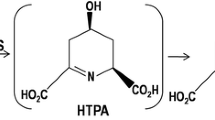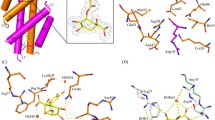Abstract
Previous research on Corynebacterium glutamicum revealed that 3-deoxy-d-arabino-heptulosonate 7-phosphate synthase (DSCg, formerly DS2098) interacts with chorismate mutase (CMCg, formerly CM0819). In this study, we investigated the interaction by means of structure-guided mutation and enzymatic assays. Our results show that the interaction imparted a new mechanism for regulation of DAHP activity: In the absence of CMCg, DSCg activity was not regulated by prephenate, whereas in the presence of CMCg, prephenate markedly inhibited DSCg activity. Prephenate competed with the substrate phosphoenolpyruvate, and the inhibition constant (K i) was determined to be 0.945 mM. Modeling based on the structure of the complex formed between DAHP synthase and chorismate mutase of Mycobacterium tuberculosis predicted the interaction surfaces of the putative DSCg-CMCg complex. The amino acid residues and structural domains that contributed to the interaction surfaces were experimentally identified to be the 212SPAGARYE219 sequence of DSCg and the 60SGGTR64 loop and C-terminus (97RGKLG101) of CMCg.



Similar content being viewed by others
References
Bradford MM (1976) A rapid and sensitive method for the quantization of microgram quantities of protein utilizing the principle of protein-dye binding. Anal Biochem 72:248–254
Davidson BE, Hudson GS (1987) Chorismate mutase-prephenate dehydrogenase from Escherichia coli. Methods Enzymol 142:440–450
DeLano WL (2002) Unraveling hot spots in binding interfaces: progress and challenges. Curr Opin Struct Biol 12:14–20
Dixon M (1953) The determination of enzyme inhibitor constants. Biochem J 55:170–171
Herrmann KM (1995) The shikimate pathway: early steps in the biosynthesis of aromatic compounds. Plant Cell 7:907–919
Ikeda M, Nakagawa S (2003) The Corynebacterium glutamicum genome: features and impacts on biotechnological processes. Appl Microbiol Biotechnol 62:99–109
Jiao W, Hutton RD, Cross PJ, Jameson GB, Parker EJ (2012) Dynamic cross-talk among remote binding sites: the molecular basis for unusual synergistic allostery. J Mol Biol 415:716–726
Kikuchi Y, Tsujimoto K, Kurahashi O (1997) Mutational analysis of the feedback sites of phenylalanine-sensitive 3-deoxy-d-arabino-heptulosonate-7-phosphate synthase of Escherichia coli. Appl Environ Microbiol 63:761–762
Kim SK, Reddy SK, Nelson BC, Vasquez GB, Davis A, Howard AJ, Patterson S, Gilliland GL, Ladner JE, Reddy PT (2006) Biochemical and structural characterization of the secreted chorismate mutase (Rv1885c) from Mycobacterium tuberculosis H37Rv: an *AroQ enzyme not regulated by the aromatic amino acids. J Bacteriol 188:8638–8648
Li PP, Liu YJ, Liu SJ (2009) Genetic and biochemical identification of the chorismate mutase from Corynebacterium glutamicum. Microbiology 155:3382–3391
Liao HF, Lin LL, Chien HR, Hsu WH (2001) Serine 187 is a crucial residue for allosteric regulation of Corynebacterium glutamicum 3-deoxy-d-arabino-heptulosonate 7-phosphate synthase. FEMS Microbiol Lett 194:59–64
Liu YJ, Li PP, Zhao KX, Wang BJ, Jiang CY, Drake HL, Liu SJ (2008) Corynebacterium glutamicum contains 3-deoxy-d-arabino-heptulosonate 7-phosphate synthases that display novel biochemical features. Appl Environ Microbiol 74:5497–5503
Pittard AJ (1996) Biosynthesis of aromatic amino acids in Escherichia coli and Salmonella. Cellular and Molecular Biology. American Society of Microbiology, Washington, pp 458–484
Romero RM, Roberts MF, Phillipson JD (1995) Anthranilate synthase in microorganisms and plants. Phytochemistry 39:263–276
Samsbrook J, Fritsch EF, Maniatis T (1989) Molecular cloning: a laboratory manual, 2nd edn. Cold Spring Harbor Laboratory Press, New York
Sasso S, Okvist M, Roderer K, Gamper M, Codoni G, Krengel U, Kast P (2009) Structure and function of a complex between chorismate mutase and DAHP synthase: efficiency boost for the junior partner. EMBO J 28:2128–2142
Schneider CZ, Parish T, Basso LA, Santos DS (2008) The two chorismate mutases from both Mycobacterium tuberculosis and Mycobacterium smegmatis: biochemical analysis and limited regulation of promoter activity by aromatic amino acids. J Bacteriol 190:122–134
Schoner R, Herrmann KM (1976) 3-Deoxy-d-arabino-heptulosonate 7-phosphate synthase. Purification, properties, and kinetics of the tyrosine-sensitive isoenzyme from Escherichia coli. J Biol Chem 251:5440–5447
Siehl DL (1997) Inhibitors of EPSP synthase, glutamine synthetase, and histidine synthesis. In: Row RM, Burton JD, Kuhr RJ (eds) Herbicide Activity: Toxicology, Biochemistry and Molecular Biology. IOS Press, Amsterdam, pp 37–67
Shumilin IA, Bauerle R, Wu J, Woodard RW, Kretsinger RH (2004) Crystal structure of the reaction complex of 3-deoxy-d-arabino-heptulosonate-7-phosphate synthase from Thermotoga maritima refines the catalytic mechanism and indicates a new mechanism of allosteric regulation. J Mol Biol 341:455–466
Tauch A, Kassing F, Kalinowski J, Pühler A (1995) The Corynebacterium xerosis composite transposon Tn5432 consists of two identical insertion sequences, designated IS1249, flanking the erythromycin resistance gene ermCX. Plasmid 34:119–131
Tauch A, Kirchner O, Loffler B, Gotker S, Pühler A, Kalinowski J (2002) Efficient electrotransformation of Corynebacterium diphtheriae with a mini-replicon derived from the Corynebacterium glutamicum plasmid pGA1. Curr Microbiol 45:362–367
Thompson JD, Gibson TJ, Plewniak F, Jeanmougin F, Higgins DG (1997) The CLUSTAL_X windows interface: flexible strategies for multiple sequence alignment aided by quality analysis tools. Nucleic Acids Res 25:4876–4882
Wang RH, Chen RC, Liu RZ (2008) A modified method of QuikChange site-directed mutagenesis. J Xiamen Univ 47:z2
Webby CJ, Baker HM, Lott JS, Baker EN, Parker EJ (2005) The structure of 3-deoxy-d-arabino-heptulosonate 7-phosphate synthase from Mycobacterium tuberculosis reveals a common catalytic scaffold and ancestry for type I and type II enzymes. J Mol Biol 354:927–939
Webby CJ, Jiao W, Hutton RD, Blackmore NJ, Baker HM, Baker EN, Jameson GB, Parker EJ (2010) Synergistic allostery, a sophisticated regulatory network for the control of aromatic amino acid biosynthesis in Mycobacterium tuberculosis. J Biol Chem 285:30567–30576
Wu J, Sheflyan GY, Woodard RW (2005) Bacillus subtilis 3-deoxy-d-arabino-heptulosonate 7-phosphate synthase revisited: resolution of two long-standing enigmas. Biochem J 390:583–590
Acknowledgments
This work was supported by a grant from the Ministry of Science and Technology of China (973-project, grant no. 2012CB721104).
Author information
Authors and Affiliations
Corresponding author
Rights and permissions
About this article
Cite this article
Li, PP., Li, DF., Liu, D. et al. Interaction between DAHP synthase and chorismate mutase endows new regulation on DAHP synthase activity in Corynebacterium glutamicum . Appl Microbiol Biotechnol 97, 10373–10380 (2013). https://doi.org/10.1007/s00253-013-4806-0
Received:
Revised:
Accepted:
Published:
Issue Date:
DOI: https://doi.org/10.1007/s00253-013-4806-0




